Charon
Latest
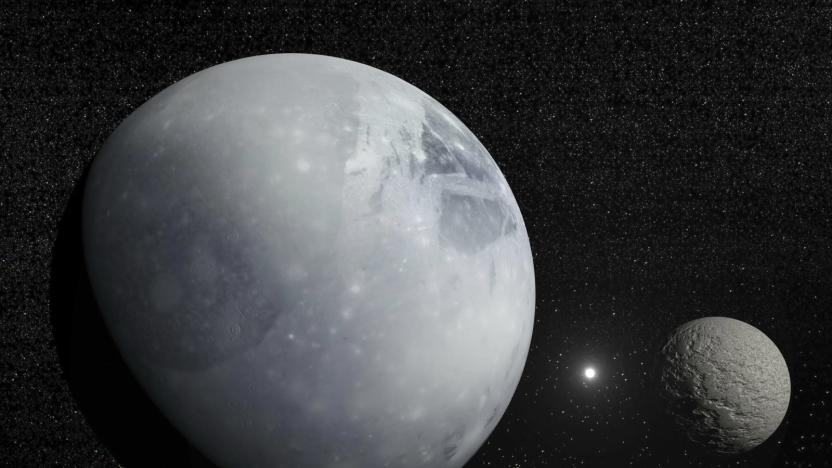
New Horizons photos shed more light on Kuiper Belt
Those of you following NASA's New Horizons know the interplanetary space probe made the farthest-ever flyby in human history on New Year's Day, when it circled Ultima Thule, an object in Kuiper Belt. Now, a discovery from New Horizons' 2015 trip around Pluto and its satellite Charon sheds even more light on Kuiper Belt, a donut-shaped region of icy bodies beyond Pluto. Analyzing photos from the probe's flyby of Pluto and Charon, scientists have discovered a surprising lack of small objects in the belt.
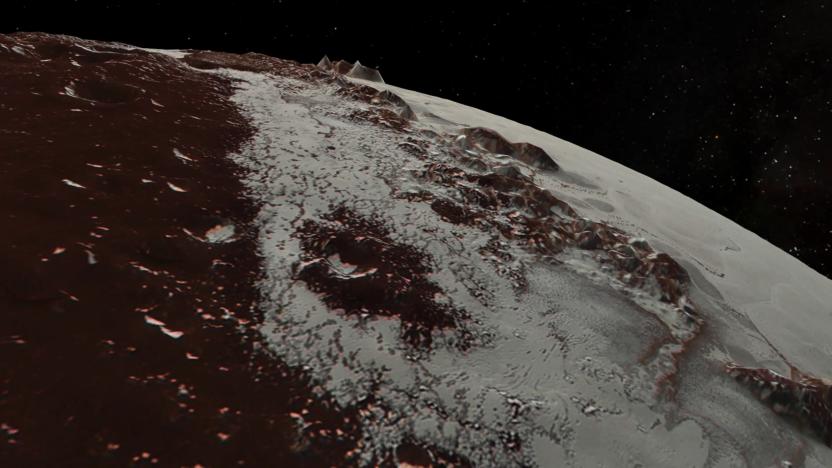
Fly over Pluto and Charon in the latest NASA footage
The New Horizons spacecraft may have moved on from Pluto, making a long march to the Kuiper Belt, but we're still deep in the process of analyzing the data it sent back. Now, for the spacecraft's one-year anniversary of its Pluto flyby, NASA has released two new videos based on digital elevation models and New Horizons' data of both Pluto and Charon. The Pluto flyover begins in Sputnik Planitia, a nitrogen ice field bordered by craters on one side (Cthulhu Macula) and mountains on the other. It moves north to Voyager Terra, which are rugged highlands, and then sweeps over the pits and craters of Pioneer Terra. The flyover ends over Tartarus Dorsa. The Charon flyover, meanwhile, surveys the canyon Serenity Chasma, before sweeping over Dorothy Gale crater and Mordor Macula, the dark polar hood of Charon. The flyover then moves south, covering an area called Oz Terra before ending at the Vulcan Planum plains and Clarke Montes mountains. It's important to note that the topographic features have been exaggerated in these videos to really give you an idea of what the landscape of Pluto and Charon are like. Additionally, NASA enhanced the colors of both dwarf planets' surfaces.
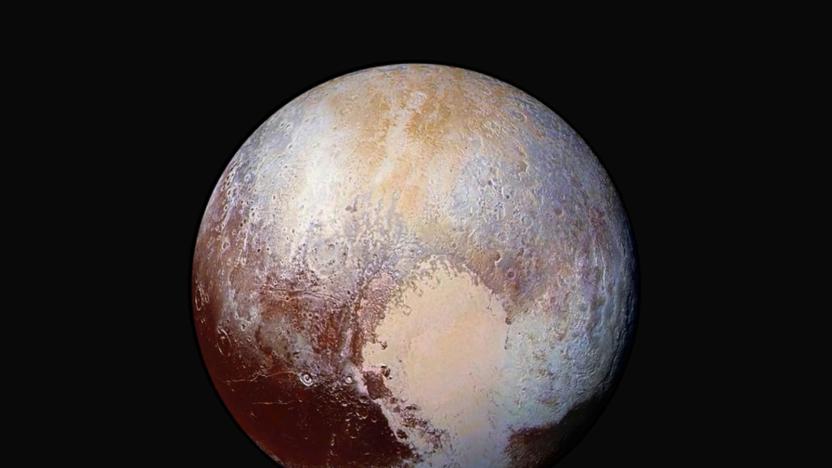
Researchers offer new evidence of a liquid ocean on Pluto
Pluto may have lost its official planet status, but the frozen world at the edge of our solar system still deserves a closer look. That's the end goal of two new studies of Pluto published in the journal Nature this month, both of which focus on Sputnik Planitia -- a 1,000-kilometer long basin covered in frozen nitrogen. As Wired notes, both papers agree that Sputnik Planitia's mass is likely responsible for throwing Pluto off its axis and creating Charon's tidal alignment, but they differ in their explanations of how a dent in the planet's surface could actually be so massive.
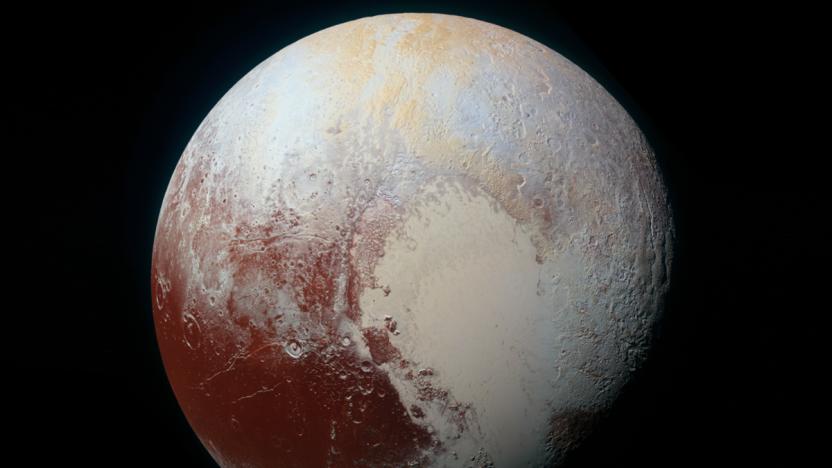
Pluto may have a 60 mile deep liquid water ocean
We used to think of Pluto as a remote frigid rock, but since the New Horizons visit, it's vying for the title of the solar system's most interesting (ex-) planet. An earlier study showed that its core is warm enough to support a liquid water ocean, and now we've learned that it might be huge -- at least 100 km (62 miles) deep. The evidence, according to the team from Brown University, comes from a likely impact with massive asteroid.

Pluto's moon Charon got its red toupée from the dwarf planet
NASA's New Horizons spacecraft showed us a part of Charon we'd never seen before: a rusty red section crowning its polar region. It's an intriguing feature, something the mission's ground team hadn't seen before, so they spent the past year studying all the data and images the probe sent back. Now, they have their answer. The red cap is apparently the product of methane gas escaping the dwarf planet itself and freezing solid in the frigid pole. Team leader Will Grundy, likens Pluto to a "graffiti artist, spray-painting its companion with a reddish stain that covers an area the size of New Mexico."
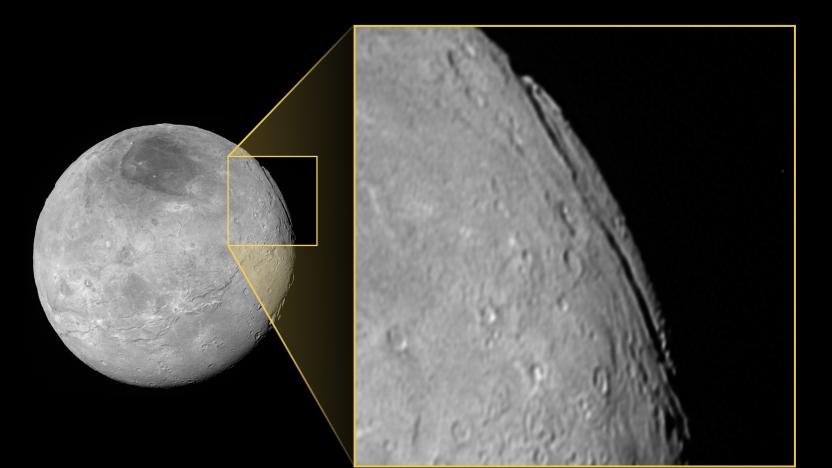
Pluto's moon Charon features a massive, deep chasm
While humans are still a long way away from going canyoneering on the moons of Pluto, we can at least start scoping out the terrain. In images shot last summer by NASA's New Horizons spacecraft, we can see one immense and interesting feature of Charon: a deep canyon dubbed the Argo Chasma that slices through one hemisphere of Pluto's largest satellite.
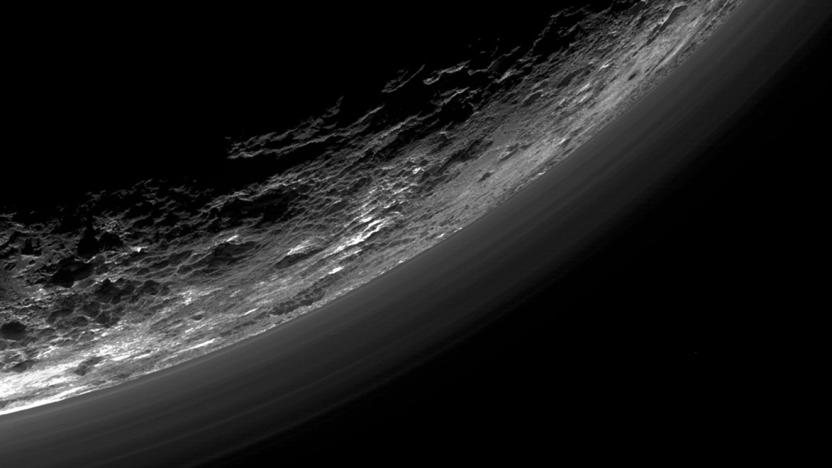
New studies detail just how complex Pluto and its moons are
Before New Horizons started sending back data and close-up images of Pluto, we barely knew the dwarf planet. We were like a love-sick fool who could only observe from afar. Now, the New Horizons scientists have enough material to publish five new papers that detail the probe's findings on the dwarf planet and its moons in Science. One of its most important discoveries is that Pluto has been geologically active for 4 billion years. Its heart-shaped region's western lobe, the Sputnik Planum, however, is relatively young at only 10-million-years-old.

New Horizons parts Pluto with a shot of its puniest moon
NASA's New Horizon's spacecraft has done yeoman's work at Pluto, having taken stunning images of the ex-planet and its major moon Charon. Now it's taking off for the largely unseen Kuiper belt, but it grabbed one last image of the tiny moon Kerberos before leaving. It turns out that the body is smaller than thought at around 8 miles across, and consists of two distinctive "lobes." Much like Comet 67P orbited by the ESA's Rosetta spacecraft, the unusual shape of Kerberos may be the result of a collision between two smaller objects. Like Pluto's other small moons, and several spots on the quasi-planet itself, it's also coated with "relatively clean water ice," making it highly reflective.

The Big Picture: NASA shows off Pluto's largest moon
As the long, slow download of data from the New Horizon's mission continues, NASA has posted some new high-res enhanced color pictures of Pluto's largest moon, Charon (shown above in the upper left corner). Other than a reddish polar region, the images also reveal a surprisingly detailed landscape with canyons, mountains and more. A video composite of images (embedded after the break) takes us flying over a canyon NASA says is four times as long as the Grand Canyon, and twice as deep. NASA says even better pictures are on the way, although with the spacecraft 3.1 billion miles away and still going, we'll be waiting a year to get everything.

Here's your closest look yet at Pluto's largest moon, Charon
Sure, Pluto may be hogging the spotlight (if deservedly so), but what about its largest moon, Charon? Don't worry, NASA hasn't forgotten about checking in on this celestial neighbor. The New Horizons probe has delivered one of the first true close-ups of Charon, and it's clear that this is much more than a nondescript chunk of ice. It's full of chasms and craters that make Earth seem flat by comparison -- the largest crevice is "miles deeper" than the Grand Canyon, for a start. There's also a curious, 200-mile "dark region" around its northern pole. The moon will play second fiddle once again when New Horizons flies by Pluto on the 14th, but it's at least getting its moment in the (very distant) sun. [Image credit: NASA/JHUAPL/SWRI]

NASA mission sends back fuzzy, color 'movies' of Pluto
Sure, Pluto doesn't have full-fledged planetary status anymore, but we're still excited to get some pictures from the edge of the Solar System. The New Horizons spacecraft is carrying a "Multicolor Visible Imaging Camera" that takes stills in blue, red, and near-infrared, then puts them together for a color picture. It took a series of pictures between May 29th and June 3rd that show the dwarf planet and its largest moon, Charon revolving around their shared center of gravity. The mission will make its closest approach to Pluto on July 14th when it gets about 7,800 miles above the surface (shown above in an artist rendering). You can check out the low-res animation after the break, and mark your calendar for the better look that's just 24 days away.

EVE Online's very own Corpse Bride
Massively multiplayer online games aren't just a passing hobby for many players out there, it's a real passion in their lives. At Massively, we frequently hear about unions of all types in MMOs -- titles which allow players to marry one another, couples who decide to tie the knot in-game, married couple experience bonuses, and now and again an inventive marriage proposal. But this is something new... EVE Online player Suva Orefinger is ready to settle down with her (real life) boyfriend, and he says he'll marry her... assuming she's willing to prove her commitment to him. In typical EVE fashion, her boyfriend's bargaining posture has led to a rather unique proposition. He's posed a challenge to Suva: fill a Charon-class freighter with corpses and he'll make his vows. This is no easy feat. A character must die for each corpse to be created in EVE, and the Charon is a massive ship, which can hold nearly 100,000 of these victims of New Eden's violence. "Something easily gotten is not highly valued," her boyfriend says. But if Suva can do it, he'll be all hers, 'til death do they part.

EVE Online player establishes new profession
Players in EVE Online pursue a wide variety of professions or careers, but are not locked into any given role at character creation. This flexibility allows a character to change their play style over time, or to capitalize on niches no one else has filled. This is the case with Dylon Xavier, an enterprising Caldari pilot with Ascendant Strategies, Inc.ISD Magnus Balteus reports that Xavier "has decided to try something different; create a product that is both time and resource consuming to build, and offer it for auction to the alliance that has the funds and space to deploy it." The niche item in this case is an Outpost Platform. When launched, it will create a space station for an alliance that can handle the minimum 20 billion isk bid on his auctions. This substantial pricetag includes a freighter for transporting the Outpost Platform and materials, and turns what is normally a time-consuming collective effort into a (comparatively) rapid-deployment. He's also willing to have Chribba, perhaps EVE's most trusted player, broker the transactions, mitigating the risk involved with such large amounts of currency. With the neverending ebb and flow of territorial control in New Eden, and if alliances continue to express interest in Xavier's venture, he may well have created a new and lucrative profession in EVE Online





